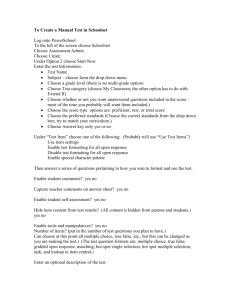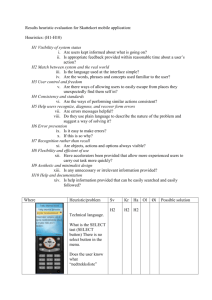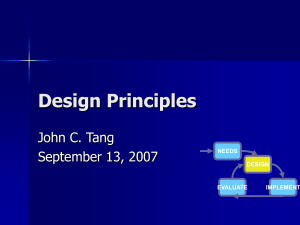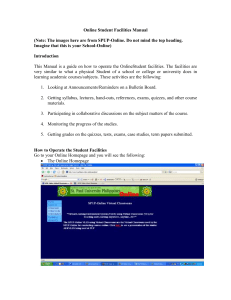design principles
advertisement
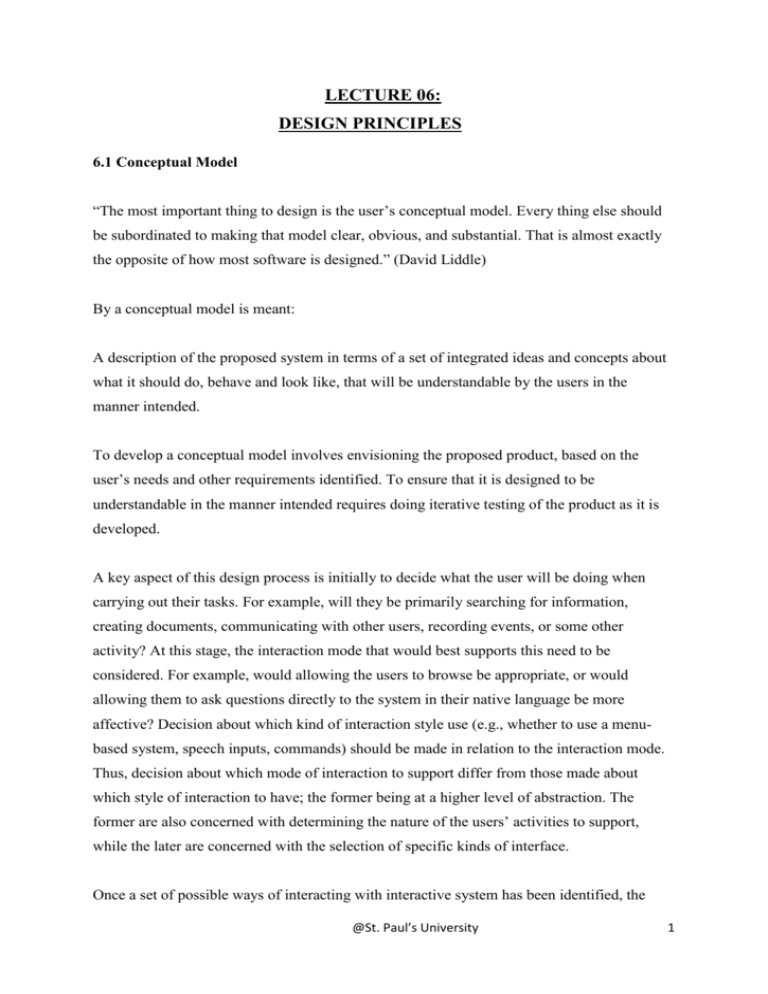
LECTURE 06: DESIGN PRINCIPLES 6.1 Conceptual Model “The most important thing to design is the user’s conceptual model. Every thing else should be subordinated to making that model clear, obvious, and substantial. That is almost exactly the opposite of how most software is designed.” (David Liddle) By a conceptual model is meant: A description of the proposed system in terms of a set of integrated ideas and concepts about what it should do, behave and look like, that will be understandable by the users in the manner intended. To develop a conceptual model involves envisioning the proposed product, based on the user’s needs and other requirements identified. To ensure that it is designed to be understandable in the manner intended requires doing iterative testing of the product as it is developed. A key aspect of this design process is initially to decide what the user will be doing when carrying out their tasks. For example, will they be primarily searching for information, creating documents, communicating with other users, recording events, or some other activity? At this stage, the interaction mode that would best supports this need to be considered. For example, would allowing the users to browse be appropriate, or would allowing them to ask questions directly to the system in their native language be more affective? Decision about which kind of interaction style use (e.g., whether to use a menubased system, speech inputs, commands) should be made in relation to the interaction mode. Thus, decision about which mode of interaction to support differ from those made about which style of interaction to have; the former being at a higher level of abstraction. The former are also concerned with determining the nature of the users’ activities to support, while the later are concerned with the selection of specific kinds of interface. Once a set of possible ways of interacting with interactive system has been identified, the @St. Paul’s University 1 design of the conceptual modal then needs to be thought through in term of actual concrete solution. This entail working out the behaviour of the inter face, the particular interaction style that will be used, and the “look and feel” of the interface. At this stage of “Fleshing out,” it is always a good idea to explore a number of possible designs and to assess the merits and problems of each one. Another way of designing an appropriate conceptual model is to interface metaphor this can provide a basic structure for the conceptual model that is couched in knowledge users are familiar with. Examples of well-known interface metaphors are the desktop and search engines Software has a behavioural face it shows to the world that is created by the programmer or designer. This representation is not necessarily an accurate description of what is really going on inside the computer, although unfortunately, it frequently is. This ability to represent the computer functioning independent of its true actions is far more pronounced in software than in any other medium. It allows a clever designer to hide some of the more unsavoury facts of how the software is really getting the job done. This disconnection between what is implemented and what it offered as explanation gives rise to a third model in the digital world, the designer’s represented model—the way the designer chooses to represent a program’s functioning to the user. Donald Norman refers to this simply as the designer’s model. In the world of software, a program’s represented model can be quite different from the actual processing structure of the program. For example, an operating system can make a network file server look as though it were a local disk. The model does not represent the fact that the physical disk drive may be miles away. This concept of the represented model has no widespread counterpart in the mechanical world. The representation between the three models is shown in Figure. @St. Paul’s University 2 The closer the represented model comes to the user’s mental model, the easier he will find the program to use and to understand. Generally, offering a represented model that follows the implementation model too closely significantly reduces the user’s ability to learn and use the program, assuming that the user’s mental model of his tasks differs from the implementation model of the software. We tend to form mental models that are simpler than reality; so if we create represented models that are simpler than the actual implementation model, we help the user achieve a better understanding. Pressing the brake pedal in your car, for example, may conjure a mental image of pushing a lever that rubs against the wheels to slow you down. The actual mechanism includes hydraulic cylinders, tubing, and metal pads that squeeze on a perforated disk, but we simplify all that out of our minds, creating a more effective, albeit less accurate, mental model. In software, we imagine that a spreadsheet scrolls now cells into view when we click on the scrollbar. Nothing of the sort actually happens. There is No sheet of cells out there, but a tightly packed data structure of values, with various pointers between them, from which the program synthesizes a new image to display in real-time. Another important thing is that there are several gulfs that separate mental states from physical ones. Each gulf reflects one aspect of the distance between the mental representation of the person and the physical components and states of the environment. And these gulfs present major problems for users. 6.1.1 The Gulf of Execution Does the system provide actions that correspond to the intentions of the person? The difference between the intentions and allowable actions is the gulf of execution. One measure of this gulf is how well the system allows the person to do the intended actions directly, without extra effort: does the action provided by the system match those intended by the person? 6.1.2 The Gulf of Evaluation Does the system provide a physical representation that can be directly perceived and that is directly interpretable in terms of the intentions and expectations of the person? The Gulf of evaluation reflects the amount of effort that the person must exert to interpret the physical @St. Paul’s University 3 state of the system and to determine how well the expectations and intentions have been met. The gulf is small when the system provides information about its state in a form that is easy to get, is easy to interpret, and matches the way the person thinks of the system. Goals The Seven Stages of Action as Design aids Intention to act The seven-stage structure can be a valuable Evaluation of the Interpretations design aid, for it provides a basic checklist of questions to ask to ensure that the Gulfs Of evaluation and execution are bridged. sequence of Interpreting the actions perception In general each stage of action requires its own special design strategies and, in turn, Provides its own opportunity for disaster. It Perceiving the would be fun were it not also so frustrating, execution of state The action sequence of the world to look over the world and gleefully analyze Each deficiency. On the whole, as you can see in figure the questions for each stage are Relatively simple. And these, in turn, boil Down to the principles of good design. Principles of good design are discussed THE WORLD Below. 6.2 Design Principles @St. Paul’s University 4 A number of design principles have been promoted. The best known are concerned with how to determine what users should see and do when carrying out their tasks using an interactive product. Here we briefly describe the most common ones • Visibility • Affordance • Constraints • Mapping • Consistency • Feedback 6.2.1 Visibility The more visible functions are, the more likely users will be able to know what to do next. In contrast, when functions are “out of sight,” it makes them more difficult to fid and knows how to use. Norman describes the controls of a car to emphasize this point. The controls for different operations are clearly visible (e.g., indicator, headlights, horn, and hazard warning lights), indicating what can be done. The relationship between the way the controls have been positioned in the car and what they do makes it easy for the deriver to find the appropriate control for the task at hand. For example, one problem that I often encounter, in word processing software I often needed to set the properties of a word document. For this logically option of properties should be in the File menu, and I have often seen it there. But once, I opened the file menu I could not find it there, I was confused. Look at the figure @St. Paul’s University 5 In confusion, I looked through all the menus but in vain. At last, surprisingly I was again looking at the file menu when I noticed the arrow at the bottom of the menu, when I clicked on that I was able to see that option again on the menu. Look at the figure below. 6.2.2 Affordance Affordance is a term used to refer to an attribute of an object that allows people to know how to use it. For example, a mouse button invites pushing by the way it is physically constrained in its plastic shell. At a very simple level, to afford means “to give a clue.” When the @St. Paul’s University 6 affordances of a physical object are perceptually obvious it is easy to know how to interact with it. For example, a door handle affords pulling, a cup handle affords grasping, and a mouse button affords pushing. Norman introduced this concept in the late 80s in his discussion of the design of everyday objects. Since then, it has been much popularized, being what can be done to them. For example, graphical elements like button, icon, links, and scroll bars are talked about with respect to how to make it appear obvious how they should be used: icons should be designed to afford clicking, scroll bars to afford moving up and down, buttons to afford pushing. There are two kind of affordance: • Perceived • Real Real Physical objects are said to have real affordances, like grasping, that are perceptually obvious and do not have to be learned. Perceived User interfaces that are screen-based are virtual and do not make sense to try to design for real affordances at the interface---except when designing physical devices, like control consoles, where affordance like pulling and pressing are helpful in guiding the user to Know what to do. Alternatively screen based interfaces are better conceptualized as perceived affordances, which are essentially learned conventions. 6.2.3 Constraints The design concept of constraining refers to determining ways of restricting the kind of user interaction that can take place at a given moment. There are various ways this can be achieved. A common design practice in graphical user interfaces is to deactivate certain menu options by shading them, thereby restricting the user to only actions permissible at that stage of the activity. One of the advantages of this form of constraining is it prevents the user from selecting incorrect options and thereby refuses the chances of making a mistake. The use of @St. Paul’s University 7 different kinds of graphical representations can also constrain a person’s interpretation of a problem or information space. For example flow chart diagram show which objects are related to which thereby constraining the way the information can be perceived. Norman classified constraints into three categories: physical, logical, and cultural. Physical constraints Physical constraints refer to the way physical objects restrict the movement of things. For example, the way an external disk can be placed into a disk drive is physically constrained by its shape and size, so that it can be inserted in only one way. Likewise, keys on a pad can usually be pressed in only one way. Logical constraints Logical constraints rely on people’s understanding of the way the world works. They rely on people’s common-sense reasoning about actions and their consequences. Picking up a physical marble and placing it in another location on the phone would be expected by most people to trigger something else to happen. Making actions and their effects obvious enables people to logically deduce what further actions are required. Disabling menu options when not appropriate for the task in hand provides logical constraining. It allows users to reason why (or why not) they have been designed this way and what options are available. Culture constraints Culture constraints rely on learned conventions, like the use of red for warning, the use of certain kinds of signals for danger, and the use of the smiley face to represent happy emotions. Most cultural constraints are arbitrary in the sense that their relationship with what is being represented is abstract, and could have equally evolved to be represented in another form (e.g., the use of yellow instead of red for warning). Accordingly, they have to be learned. Once learned and accepted by a cultural group, they become universally accepted conventions. Two universally accepted interface conventions are the use of windowing for displaying information and the use icons on the desktop to represent operations and documents. @St. Paul’s University 8 6.2.4 Mapping This refers to the relationship between controls and their effects in the world. Nearly all artefacts need some kind of mapping between controls and effects, whether it is a flashlight, car, power plant, or cockpit. An example of a good mapping between controls is effect is the up and down arrows used to represent the up and down movement of the cursor, respectively, on a computer keyboard. The mapping of the relative position of controls and their effects is also important. Consider the various musical playing devices. How are the controls of playing rewinding and fast forward mapped onto the desired effects? They usually follow a common convention of providing a sequence of buttons, with the play button in the middle, the rewind button on the left and the fast-forward on the right. This configuration maps directly onto the directionality of the actions. Imagine how difficult it would be if the mapping in figure (a) were used. 6.2.5 Consistency This refers to designing interfaces to have similar operations and use similar elements for @St. Paul’s University 9 achieving similar tasks. In particular, a consistent interface is one that follows rules, such as using the same operation to select all objects. For example, a consistent operation is using the same input action to highlight any graphical object at the interfaces, such as always clicking the left mouse button. Inconsistent interfaces, on the other hand, allow Exceptions to a rule. An example of this is where certain graphical objects (e.g., email messages presented in a table) can be highlighted using the right mouse button, while all other operations are highlighted using the left button. A problem with this kind of inconsistency is that is quite arbitrary, making it difficult for users to remember and making the users more prone to mistakes. On of the benefits of consistent interfaces, therefore, is that they are easier to learn and use. Users have to learn only a single mode of operation that is applicable to all objects. This principle worked well for simple interfaces with limited operations, like mini CD player with small number of operations mapped onto separate buttons. Here all the user has to do is learn what each button represents and select accordingly. However, it can be more problematic to apply the concept of consistency to more complex interfaces, especially when many different operations need to be designed for. For example, consider how to design an interface for an application that offers hundreds of operations. There is simply not enough space for a thousand buttons, each of which maps onto an individual operation. Even if there were, it would be extremely difficult and time consuming for the user to search through them all to find the desired operation. A much more effective design solution is to create categories of commands that can be mapped into subsets of operations. For the word-processing application, the hundreds of operation available are categorized into subsets of different menus. All commands that are concerned with file operations are placed together in the same file menu. Another problem with consistency is determining what aspect of an interface to make consistent with what else. There are often many choices, some of which can be inconsistent with other aspects of the interface or ways of carrying out actions. Consider the design problem of developing a mechanism to let users lock their files on a shared server. Should the designer try to design it to be consistent with the way people lock things in the outside world (called external consistency) or with the way they lock objects in the existing system (called internal consistency)? However, there are many different ways of locking objects in the @St. Paul’s University 10 physical world (e.g., placing in a safe, using a padlock, using a key, using a child safety lock), just as there are different ways of locking electronically. The problem facing designer knows which one to be consistent with. 6.2.6 Feedback Related to the concept of visibility is feedback. This is best illustrated by an analogy to what everyday life would be like without it. Imagine trying to play a guitar, slice bread using knife, or write a pen if none of the actions produced any effect for several seconds. There would be an unbearable delay before the music was produced, the bread was cut, or the words appeared on the paper, making it almost impossible for the person to continue with the next strum, saw, or stroke. Feedback is about sending back information about what action has been done and what has been accomplished, allowing the person to continue with the activity. Various kinds of feedback are available for interaction design—audio, tactile, verbal, visual, and combinations of these. Deciding which combinations are appropriate for different kinds of activities and interactivities is central. Using feedback in the right way can also provide the necessary visibility for user interaction. @St. Paul’s University 11

